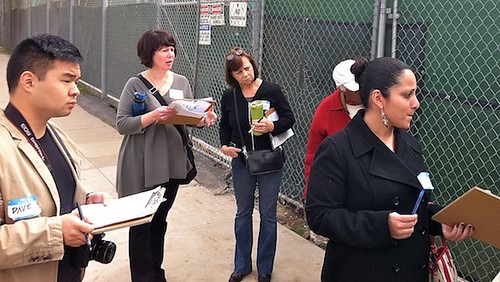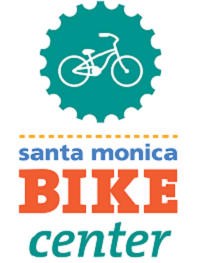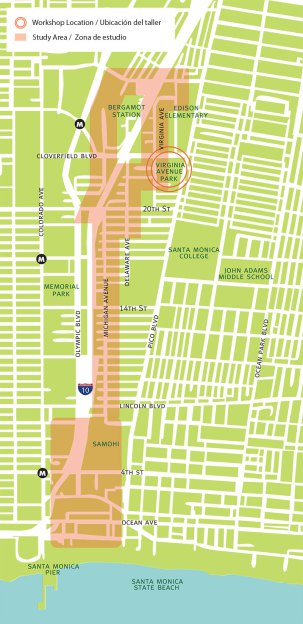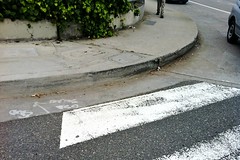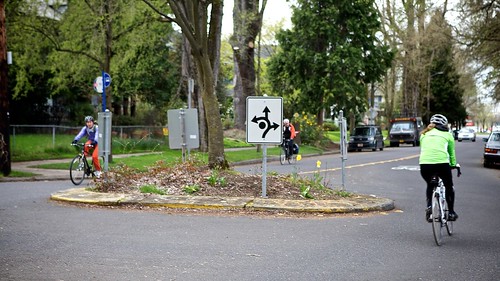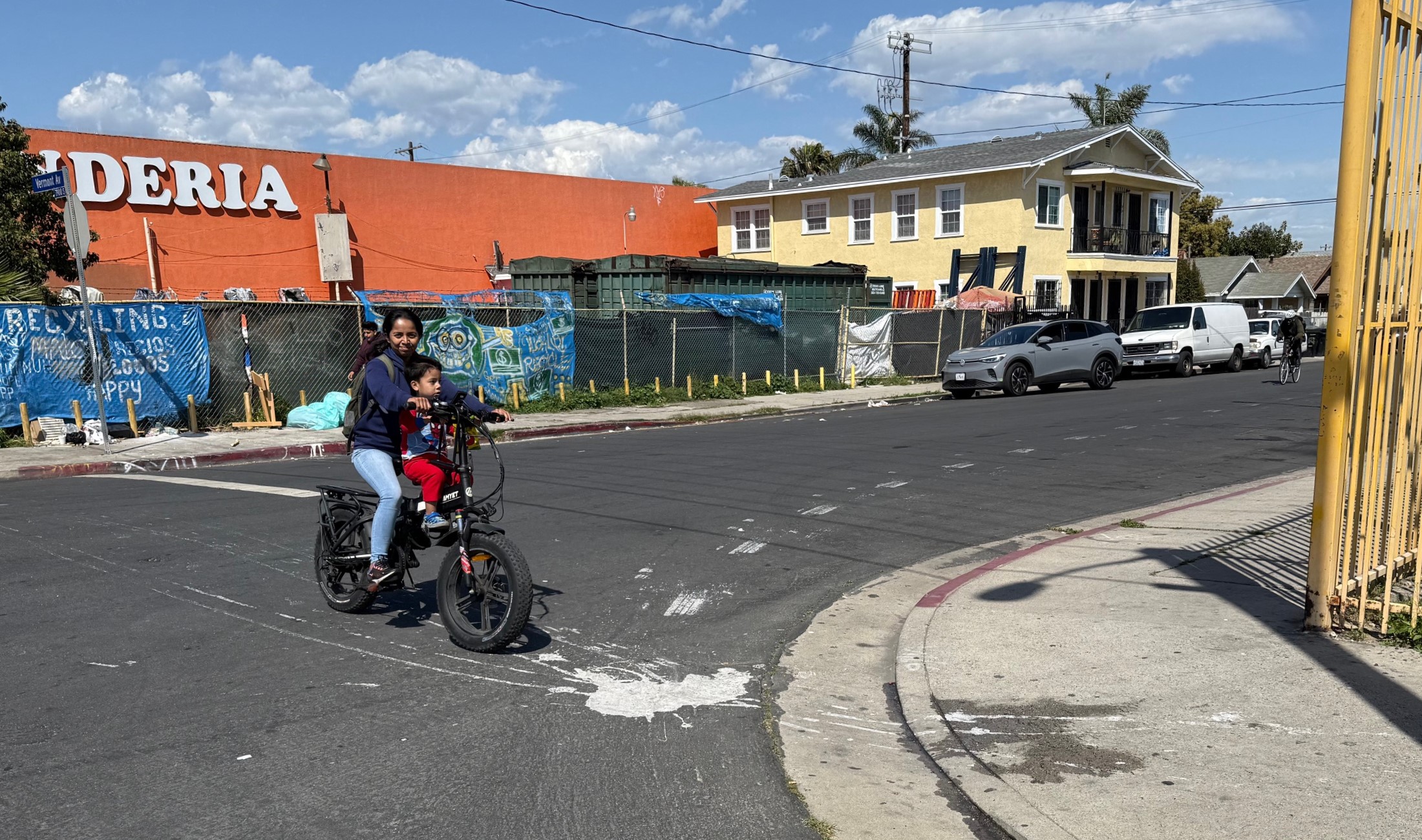This past Saturday marked the beginning of the public process for a proposed Michigan Avenue Neighborhood Greenway in Santa Monica (a video of the concept for the unfamiliar). This is one of the more high profile projects called for in the early scope of Santa Monica’s Bike Action Plan, although the greenway concept goes far beyond bicycling, and requires it's own public process to proceed. The good news is by the end of the workshop I think a lot of people came away with good ideas and valuable conversations.
However things got off to a bit of rocky start, and anyone who left before the hosted bike & walk audits may have left with a very different impression of community sentiment of those present.
Melani Smith of the Los Angeles based urban planning & design firm Meléndrez kicked off a loose presentation on what greenways tend to feature, with a few photos examples. In the immediate Q&A before the workshop portion, a few heated questions and concerns were asked involving traffic generally, and the fear of neighborhood gentrification, an issue that goes much deeper than just the design of streetscapes. Dealing with these concerns is a tightrope city planners have to walk. Under investment in the Pico Neighborhood frequently draws criticism (something I have criticized myself before), but apparently so to can proposing new investments.
Understanding debates about change in the Pico Neighborhood, which happens to be the area of Santa Monica I’ve lived for the past seven years, requires a little of the history that goes further back. The neighborhood, which has long been the most diverse in the city, and with what had been one of the largest black populations in the Westside of the LA region, was quite literally ripped in half back during the Santa Monica freeway development. Many homes were bought out though eminent domain and destroyed, with the loudest and most influential constituencies pushing projects away, the consequences of getting a freeway to the beach fell hardest on other neighborhoods with less influential voices.
The Pico Neighborhood remains with a literal and figurative divide, along with the brunt of the air toxins associated with high traffic volume freeways. With property anywhere in Santa Monica increasingly in demand, and rents going up, some members of the community are now concerned that what's left of ethnic and economic resident diversity in Santa Monica is increasingly at risk. Why gentrification occurs and where, and how best to ensure people are not displaced from the community as things change (and many changes pressing in on Santa Monica are beyond the scope of the city's own choices as well), are topics I don't feel I have done enough research on to write on as confidently as I do transportation. However I do know enough to know it's a complex, multifaceted, and loaded issue.
Anyone advocating for new ideas or proposals within the Pico Neighborhood, regardless of what they may be, or however well intentioned, would do well to make themselves aware of it’s history and context, and spend some time listening. People with deep ties in the area have an understandable and warranted skepticism when they hear talk of deliberately changing things, and have been burned in the past.
Having lived for a number of years in the area and now on both sides of the I-10 freeway, there is no denying the neighborhood often feels like two separate worlds across that deep chasm. My wife Meghan has encountered being told once that we "don't really live in the Pico Neighborhood", now that we are living on the north side of the freeway. The bridges adjacent on and off ramps are often terrible places to try and walk or bike. The choke points created by having so many north/south streets no longer connecting in the grid, and the pull of vehicles to those on-ramps, creates headaches for drivers trying to cross at peak times.
The outreach and studying for the proposed greenway is being funded by a Caltrans Environmental Justice Grant, specifically to improve air quality and quality of life in areas that got dumped on by state highway planners in the past. The most horrible, dangerous, and uncomfortable places to be in the neighborhood are those areas managed by Caltrans or nearest its handiwork, so they definitely owe the community.
The format of the workshop portion was very loose and open. There's no diagrams of anything yet, and members of the public were led on routes through the neighborhood with clip boards jotting notes on their surroundings. There were 2 bike groups, led with help by Santa Monica Spoke, and 2 walking groups all covering slightly different territory.
I went out with one of the walking groups, in part because I think the pace of walking is the best way to take in the details of any environment. Also because I was interested in listening to and chatting with more folks outside the usual bike advocacy circles. It’s great to get out and walk around the environment of a proposal area. Photos in a slide show often miss the details, and the real world experience of traffic volumes, speed, sound, and the tension at certain crossings. We saw at least one instance of a driver blowing a red light at high speed on our walk.
Talking and walking with people also seems to foster more genuine dialogue than sitting across in chairs. Out in the field it was plainly obvious to just about everyone in my group where enhancement is needed, especially at and around the connections with streets that cross the freeway.
As someone who spent a lot of time living right off of Michigan Ave., walking and biking the corridor often, and still uses Michigan regularly as a bike route alternative to the fist clenching adrenaline fests of Pico Blvd. and Olympic, I have high hopes for this corridor to be calmed a little. The traffic volumes are lower than adjacent corridors, but are enough, and fast enough, at certain times, to be stressful and threatening, to the detriment of related efforts to foster more walking and bicycling to campus for Samohi. The Michigan Avenue corridor is an absolutely critical alternative connection.
In my time wondering Portland, Oregon by bike, it was their network of neighborhood greenways which left the biggest impression on me. These became my go to routes for navigating many parts of the city. The speeds were slow enough, the volumes low enough, that the greenways were chill environments to ride and conducive to side by side conversational cycling with friends without harassment. The signage and markings made them easy to navigate to find where you were going even as a tourist, and bike ridership on some corridors seemed to far exceed the car traffic.
The slate is pretty open for how things may take shape, and I encourage people to get involved. If you live in the Pico Neighborhood area or know people who do, maybe chat it up with them or with neighbors. The more support we can turn out from people in the immediate area the better. Some potential design features including neighborhood roundabouts (which I love for reducing top speeds and turn conflicts) may be more controversial than others. We need a broad coalition to ensure this corridor reaches the full potential of what a neighborhood greenway network could be.
This goes far beyond bicycling, it's about enhancing public safety, public health and our environment.
